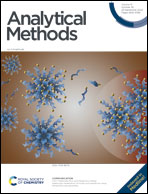Microplastic in situ detection based on a portable triboelectric microfluidic sensor
Abstract
Microplastics (MPs) are a size-based category of plastic pollutants between 1 μm to 5 mm in particle size that are ubiquitous in land and water resources due to anthropogenic activity. Current methodologies for MPs identification and characterization require laboratory instruments and specialized training. In the present study, a miniaturized microfluidic triboelectric sensor (M-TES) is proposed for the rapid detection of MPs from water samples. The viability and versatility of this device is illustrated for in situ measurement of the size and concentration of polystyrene (PS) micro-particles in water. The M-TES sensor relies on inducing and measuring electrical charges generated by microplastic flow within water droplets passing through a microfluidic channel. The experimental samples encompass pure polystyrene (PS) microparticles ranging from 500 nm to 10 μm, as well as actual samples collected from a coffee machine. The results reveal that the sensor's response exhibits a linear correlation with the increase in both microplastic size and concentration. The proposed sensing system could distinguish between microplastics of different sizes and concentrations. The results demonstrate the applicability of the M-TES in the field of sensors for environmental monitoring.



 Please wait while we load your content...
Please wait while we load your content...